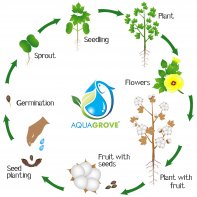
Lessons in Aquaponics: Plant Life Cycle
To successfully grow plants, vegetables and flowers in your aquaponic system, it is important to have a basic understanding of the plant life cycle. With many AquaGrove growers being students, some of the information about plants and their life cycle may be a given, but a refresher can help students of all ages better manage and maintain plants in their systems.
When looking at flowering plants in general, the life cycle begins with a seed. The seed will sprout and produce a tiny, immature plant called a seedling. The seedling will grow to adulthood and form a mature plant. The mature plant will reproduce by forming new seeds which will begin the next life cycle (see image).
Plant Care
Choosing the right environment in which to place your aquaponic garden is an important consideration. The amount of sunlight, ambient temperature, rainfall, and wind are all crucial factors in producing a healthy plant. If you decide to grow outdoors, choose varieties of vegetables that will grow best in your particular climate. Additionally, some areas may require the use of a greenhouse, but with AquaGrove and its grow lights, growers may choose to simply grow indoors.
Even with a greenhouse, it is difficult to control the temperature, and plants thrive better when the temperature ranges match their normal processes. Therefore, in the colder months you should grow cold-weather crops and in the summer, you should grow your warm-weather plants. As previously mentioned, these factors don’t play as significant of a role when growing with AquaGrove because much of the light exposure and temperature can be easily controlled within and around the system.
It’s important to carefully schedule your planting times. If you’re looking to produce a sustained food supply, you should stagger your projected harvests so that all of your produce doesn’t become ripe at the same time. When harvests are not staggered, it can lead to wasted food, as well as in-between periods where your aquaponic garden isn’t producing any vegetables. If you plan to grow multiples of the same vegetable, consider staggering the growing periods by approximately the amount of time it will take you to consume a batch.
One of the quickest-yield vegetables you can grow in an aquaponic system is lettuce. Reaching peak maturity at around 28 days, lettuce grows ideally in floating beds. It is very forgiving in terms of the minimum and maximum water temperatures and can survive a range from 25-85 degrees Fahrenheit.
If you’re looking to produce a more nutrient-dense plant in a short amount of time, pole, an Italian-style wax bean, can be harvested in around 54 days. Pole grows best in a media bed and is optimal at temperatures between 59 and 95 degrees Fahrenheit. Beans overall are an excellent investment, as they can be dried and stored for very long periods of time.
When thinking about the plants you would like to grow with your AquaGrove system, check out our previous post ("What to Grow with AquaGrove") for some ideas and inspiration to get started.
To learn more about aquaponics and how to begin your own sustainable and organic garden, contact AquaGrove.
